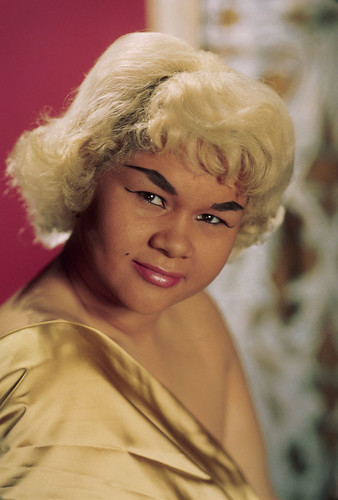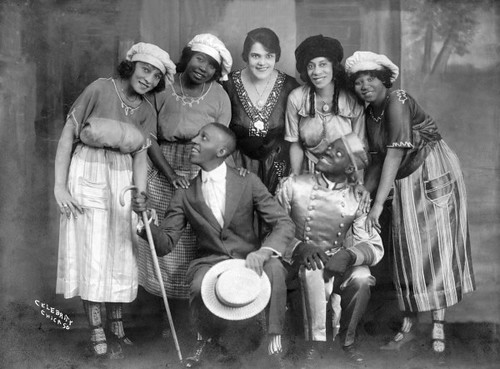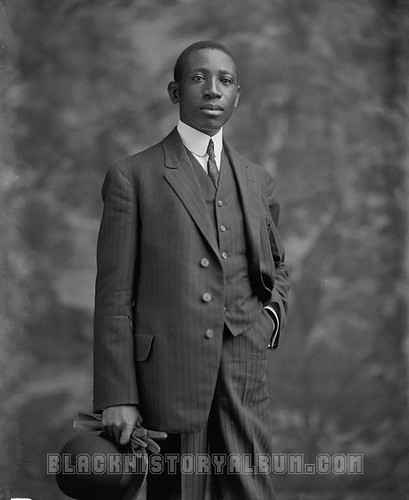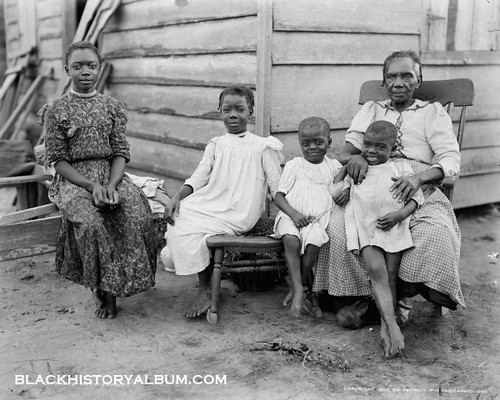
Winner of six Grammys and 17 Blues Music Awards. Inducted into the Rock & Roll Hall of Fame in 1993, the Blues Hall of Fame in 2001, and the Grammy Hall of Fame in both 1999 and 2008. Ranked number 22 on Rolling Stone's list of 100 Greatest Singers of All Time and number 62 on the list of the 100 Greatest Artists.
Greatest hits include "Dance With Me, Henry", "At Last", "Tell Mama", and "I'd Rather Go Blind."
Josephine Baker herself

Studio Harcourt
I think Miss Jo looks gorgeous in this image. I have never seen her in a photo like this, She looks so elegant and beautiful.
The Bronze Bombshell

Joyce Bryant
Philippe Halsman, Photographer
Joyce Bryant, "the Bronze Blond Bombshell," never achieved Eartha Kitt or Lena Horne popularity, but the supper club chanteuse is still fondly remembered. The four octave singer, aka the black Marilyn Monroe, "the Voice You'll Always Remember," and "the Belter," was born in Oakland, CA, but raised in San Francisco (the oldest of eight children).
Her act was outrageously sexy; she wore provocative, tight, backless, cleavage-revealing mermaid dresses that left little to the imagination and they were so tight, she had to be carried off-stage. Supposedly, Bryant twisted so much she lost four pounds a performance. Bryant's hair was naturally black, but not wanting to be upstaged by Josephine Baker at a club, she doused it with silver radiator paint, slithered into a tight silver dress and voila: the Bronze Blond Bombshell and even Baker was impressed.
The gimmick and Bryant's elastic voice elevated the singer to heavyweight status; she earned as much as $3500 dollars a gig and $150,000 dollars a year in the early 1950s. She was called one of the most beautiful black women in the world and regularly appeared in Black magazines such as Jet. And a Life magazine layout in 1953.
Joy Ride | 1937

An African American woman posed next to car on Mulford Street, Homewood (Pittsburgh, PA), c. 1937
Photo Credit: Teenie Harris Archive, 1920-1970 © Carnegie Museum of Art, Pittsburgh, PA
Charles "Teenie" Harris photographed the events and daily life in Pittsburgh's African American community between 1936 and 1975 for the Pittsburgh Courier, one of the nation's most influential Black newspapers. A retrospective exhibition, Teenie Harris, Photographer: An American Story,is on view at Carnegie Museum of Art October 29, 2011, through April 7, 2012.
It's Showtime | 1920s

A group of African American vaudeville entertainers. Undated. Source: The Black Archives of Mid-America (Kansas City, MO), www.blackarchives.org.
Field of Dreams | 1938

An African American migrant worker hoeing cotton in preparation for planting (Louisianna), 1938
Martha | 1898

Portrait of African American girl, seated. Hand-colored tintype, c. 1898
Annie Mae Manigault
[b.1907 - d.1976]

Annie Mae Manigault graduated from the Renouard School of Embalming in New York City, and then began her fifty-year career by working with her parents (Annie Rivers and William Manigault) in the Manigault Funeral Home in Columbia, South Carolina.
*************************************
A little about her parents:
In 1917, William and Annie Manigault helped found the Manigault-Gaten-Williams Funeral Home, in Columbia, SC. In 1923, the funeral home was renamed Manigault's Funeral Home. Both William and Annie were funeral directors and worked hard to serve families in need during a time when it was not easy for African American people to be in business.
Annie and William also founded the Congaree Casket Company, which employed more blacks during that time than any other black-owned business in South Carolina.
In the early 1950’s, William and Annie's daughter, Anna Mae, took over the family business, which she ran along with her son, Anthony.
Today, the Manigault-Hurley Funeral Home is run by Anthony Manigault Hurley, Alice Wyche Hurley, Michelle Manigault Hurley Johnson, and Kelly Lynn Hurley.
Richard S. Roberts, Photographer
House of Glass | 1911

Two generations of glass factory workers, Alexandria, VA, 1911.
Courtesy of Blackhistoryalbum.com, The Way We Were.
Mother of Hip Hop

Sylvia Robinson
[b.1936 - d.2011]
She made an indelible mark on African-American music as a singer, producer and record company owner. She sang on hit records from the 1950s to the 1970s, and then became known as "the mother of hip-hop" after she was among the first to recognise the potential of the nascent rap scene in the streets and clubs of New York.
The Help

set in Mississippi during the 1960s) by a couple of decades.
Original caption: A pair of African American house maids/nannies taking a baby for a stroll, Mississippi, 1940.
Vintage African American photography courtesy of Black History Album, The Way We Were.
They Call Me Mr. Tibbs | 1915

Courtesy of Blackhistoryalbum.com, The Way We Were.
This man looks pretty smooth to me. A wonderful powerful image of a young black man during the early 1900's.
Boarding House Blues | 1948

Despite the slapstick atmosphere there, the inhabitants of Moms' theatrical boarding house in Harlem are broke and in danger of losing their home. For some ready cash, they trick a producer into helping them put on a show, featuring a variety of black specialty acts.
Directed by Josh Binney. With Moms Mabley, Dusty Fletcher, Marcellus Wilson, Marie Cooke.
Because films like Boarding House Blues were aimed specifically at segregated inner-city black audiences ("race films"), they were often treated like disposable product by the studios, allowing them a surprising amount of leeway in terms of material. Drug jokes and sexual innuendos, which would surely have been censored in mainstream films in 1948, rub elbows with some truly bizarre novelty acts including a dancer with one arm and one leg and an acrobat dressed like a monkey.
WV Medical Society Convention 1939

from wvgenweb.org: Dr. A.D. Belton, who has been practicing in Beckley since 1928, is a native of Palatka, Fla. He is a graduate of Florida Baptist Academy at Jacksonville, Fla., received his AB degree at Lincoln University in 1922 and his medical degree from Howard University in Washington, D.C., in 1926. He did his internship at Freedman's Hospital in Washington. Dr. Belton first practices at Mount Hope, locating there in 1927. He is a member of a large number of medical and civic societies, including the West Virginia Medical Society, of which he is executive secretary; medical supervisor of the West Virginia Home for the Ages and Infirm at McEndree. Dr Belton is also on the Board of Trustees at the Ebernezer Baptist Church.
First African American Professional Footballer (1899)

Wooster High School Football Team Photo: (top row) Smith, Shelhart, and Curry; (second row) F. Redick, Goldsmith, Capt. Charles Follis (holding ball), Marchant, and Webb; (third row) Gravatt, Yeager, Reed, and Hoelzel; (bottom row) Sharp and Leyda.
Charles W. Follis
[b.1879 - d.1910]
The first African American professional football player, Charles W. Follis, was born February 3, 1879, in Cloverdale, Virginia. The Follis family moved to Wooster, Ohio, where he attended Wooster High School and participated in organizing and establishing the first varsity football team. He played right halfback and served as team captain on a squad that had no losses that year.
In 1901, Follis entered the College of Wooster. Rather than playing football for the college, he played for the town’s amateur football team – the Wooster Athletic Association, where he earned the nickname of the “Black Cyclone from Wooster.”
In 1902, Frank C. Schieffer, manager of the Shelby Athletic Club secured employment for Follis at Howard Seltzer and Sons Hardware Store in rural Shelby, Ohio. The six-foot, 200-pound Follis played for Shelby in 1902 and 1903.
In 1904, Follis signed a contract with the Shelby Athletic Club, later the Shelby Blues. With that contract, he became the first professional African American football player. Follis played on the team with Branch Rickey, the Ohio Wesleyan University student and future Brooklyn Dodger owner who would sign Jackie Robinson to integrate major league baseball in 1947.
Like other players who integrated sport teams, Follis faced discrimination. Players on other team targeted Follis with rough play that resulted in injuries. At a game in Toledo in 1905, fans taunted him with racial slurs until the Toledo team captain addressed the crowd and asked them to stop. In Shelby, Follis joined his teammates at a local tavern after a game; the owner denied him entry. At the Thanksgiving Day game of the 1906 season, Follis suffered a career-ending injury.
Follis turned to baseball, a sport he played for many years in the spring and summer. Having played for the Wooster College and in the Ohio Trolley League, Follis was an experienced baseball player, but could only play in segregated baseball leagues. He played for the Cuban Giants, a black baseball team, as a catcher.
On April 5, 1910, at the age of 31, Follis died of pneumonia in Cleveland, after playing in a Cuban Giants game. He was buried in Wooster Cemetery in Wooster, Ohio.
Photo: Wayne County Public Library
Charles K. Ross, 'Outside the Lines: African Americans and the Integration of the National Football League' g" width="500" />
Williams & Walker

Yale Collection of American Literature, Beinecke Rare Book and Manuscript Library
Grandma's House | 1903

African American grandmother surrounded by her grandkids, Louisiana, 1903.
Courtesy of Blackhistoryalbum.com, The Way We Were.
Here Comes The Bride | 1950

Bride and groom clowning around with their wedding attendants post-ceremony. Detroit, MI, 1950.
Photo Credit: Walter Lawrence Smith Collection, Charles H. Wright Museum of African American History.
Courtesy of Blackhistoryalbum.com, The Way We Were.
All images above are from Blackhistoryalbum.com





































